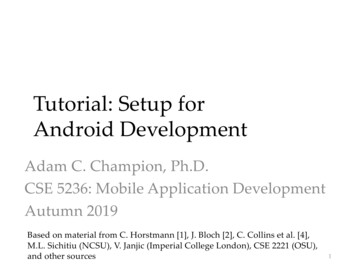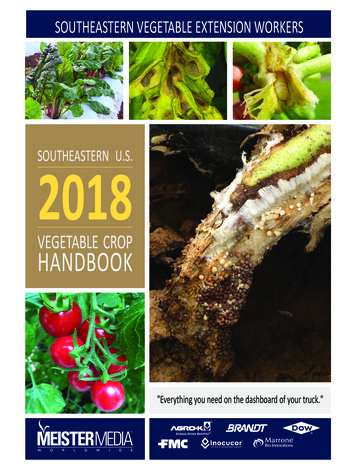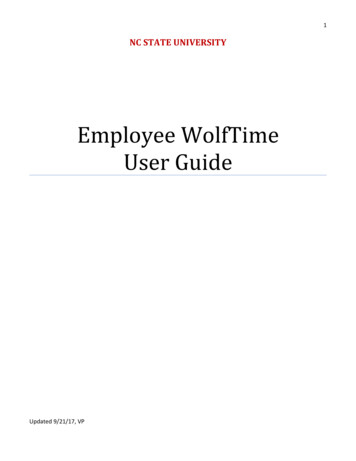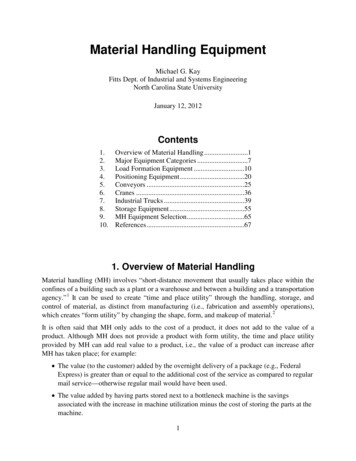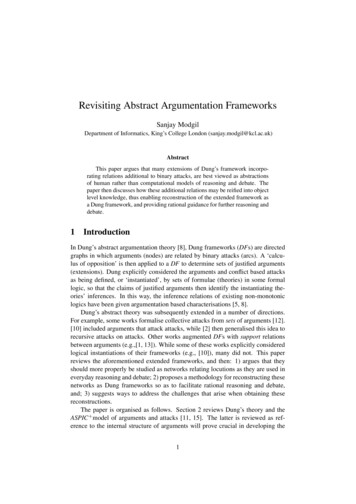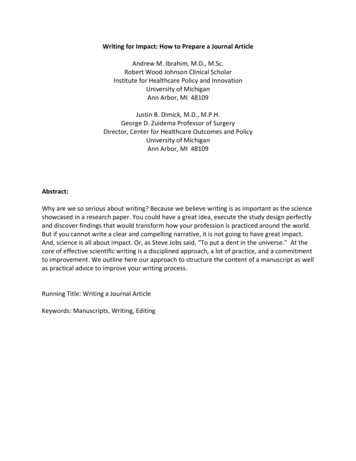
Transcription
ABSTRACTHEIKEN, JULIA ANNE. The Effects of Fluopyram on Nematodes. (Under the direction ofCharles Opperman).Nematodes are microscopic roundworms that can live freely in many differentenvironments or as parasites of animal or plants hosts. Plant-parasitic nematodes aresignificant pests, resulting in an estimated US 100 billion annual global crop losses. Thishigh level of impact on agriculture is due to many reasons including the lack of availablecontrol methods such as registered nematicides. Historically successful chemical nematicideshave lost registration due to environmental and human health risks. As a result, growers oftenare faced with a need for safe but effective chemical control method for plant-parasiticnematodes but few available options. Fluopyram (Velum ), a fungicide, was discovered tohave nematicidial properties. The mode of action for fluopyram against fungi has beendetermined to be a succinate dehydrogenase inhibitor (SDHI), however the mode of action innematodes has yet to be confirmed. The first objective of this work was to confirm the modeof action in nematodes by using a succinate dehydrogenase (sdh1) mutant of Caenorhabditiselegans. Nematodes incubated in fluopyram solution appeared dead (straightened and nonmotile) and the EC50 for wild type C. elegans was found to be 11.4 ppm while the EC50 forknockdown the sdh1 mutant was more sensitive at 4.31ppm fluopyram. The oversensitiveresponse observed in the sdh1 mutant compared to wild type C. elegans confirmed thatsuccinate dehydrogenase is the likely target for fluopyram mode of action in nematodes. Thesecond objective was to assess the potential ovicidal effect of fluopyram for C. elegans aswell as the plant-parasitic nematodes species Meloidogyne incognita and Heteroderaglycines. It was determined that there was significant (p 0.05) effect on hatch rate at 25, 35,and 50ppm fluopyram for M. incognita and H. glycines but no significance in C. elegans
hatch rate, due to the reduced permeability of eggshells of C. elegans to fluopyram. The thirdobjective was to determine potential reversible effects of fluopyram on C. elegans and M.incognita. C. elegans exposed to fluopyram for 24 hours did not recover while M. incognitaexposed to fluopyram for 1 hour did recover, suggesting that time of exposure to fluopyramwas critical to durable activity. The final objective was to assess the potential affect soil typemight have on fluopyram’s ability to control nematode populations in plants inoculated withM. incognita or H. glycines eggs and grown in three different soil types. The ability offluopyram to reduce plant root infection by M. incognita or H. glycines was not significantlyreduced in soil types ranging from coarse sand the high organic matter potting mix.
Copyright 2017 by Julia HeikenAll Rights Reserved
The Effects of Fluopyram on NematodesbyJulia Anne HeikenA thesis submitted to the Graduate Faculty ofNorth Carolina State Universityin partial fulfillment of therequirements for the degree ofMaster of SciencePlant PathologyRaleigh, North Carolina2017APPROVED BY:Charles H. OppermanCommittee ChairEric L. DavisMichael R. Schwarz
iiDEDICATIONI would like to dedicate this document and all the work that went into it to my parents Jeffand Sondra Heiken. Thank you for support through my life and believing in me.
iiiBIOGRAPHYJulia Heiken was born on April 28, 1993 in Orlando, Florida. She completed her Bachelors ofScience degree in Plant and Soil Science with a concentration in Crop Biotechnology atNorth Carolina State University in 2015. In the fall of 2015, Julia accepted research programat North Carolina State University in the Department of Entomology and Plant Pathology topursue her Master of Science. She was awarded the Bayer CropScience Fellowship in PlantPathology to research the effects of fluopyram on nematodes.
ivACKNOWLEDGMENTSI would like to thank my family and friends for their undying support during mygraduate career and throughout my life leading to this opportunity as well. Their emotionalsupport has been essential in my success as a graduate student. I would like to thank my dog,Jack, for keeping me sane and happy. I am especially thankful to my committee members,Drs. Charles H. Opperman, Eric L. Davis, and Michael R. Schwarz. Their guidance duringthis project has been essential for my success and they have also given me a great deal ofadvice and support.Outside my committee, I have been mentored by Chunying (Lisa) Li and DaveDickey during graduate career that I would like to thank. Lisa, who has served as labmanager, has supported me throughout my entire time at NC State with her knowledge ofplants, nematodes and more in addition to being a great emotional support. Dave Dickey hasserved as my CALS statistical consulting while working on my graduate degree. I would liketo thank the undergraduate assistants who helped me including Andrew Fiest, Chelsea Senter,Joshua Berning, and Cole Dunbar.Finally, I would like to thank Bayer CropScience for selecting me as the BayerCropScience Fellow in Plant Pathology. This has provided me with financial support as wellas additional opportunities for professional development.
vTABLE OF CONTENTSLIST OF FIGURES . viiLITERATURE REVIEW . 1WHAT IS A NEMATODE? . 1CAENORHABDITIS ELEGANS AS A MODEL ORGANISM . 1LIFE CYCLE OF CAENORHABDITIS ELEGANS . 3PLANT-PARASITIC NEMATODES . 5SIGNIFICANCE OF PLANT-PARASITIC NEMATODES . 6LIFE CYCLE OF MELOIDOGYNE INCOGNITA . 8LIFE CYCLE OF HETERODERA GLYCINES . 10MANAGEMENT OF NEMATODES . 11PROPERTIES OF FLUOPYRAM . 20FLUOPYRAM AS A FUNGICIDE . 21FLUOPYRAM AS A NEMATICIDE . 21THESIS OBJECTIVES . 22REFERENCES . 24IN VITRO EFFECTS OF FLUOPYRAM ON NEMATODES. 30ABSTRACT . 30INTRODUCTION . 30MATERIALS AND METHODS . 35Nematode propagation . 35Nematode egg extraction . 36Effect on C. elegans life stages. 36Recovery of C. elegans after 24 hour fluopyram exposure . 38Recovery of M. incognita after 1 hour fluopyram exposure . 38Effect on hatch rate of C. elegans . 39Effect on hatch rate of M. incognita and H. glycines . 39Statistical Analysis . 40Doses response curve generation . 41RESULTS . 41Effects on nematode hatch rate . 41Effects of exposure to fluopyram on C. elegans life stages . 42Recovery of C. elegans after 24 hour fluopyram exposure . 42Recovery of M. incognita after fluopyram exposure . 43DISCUSSION . 44REFERENCES . 47IN PLANTA EFFECTS OF FLUOPYRAM ON NEMATODES . 57
viABSTRACT . 57INTRODUCTION . 57MATERIALS AND METHODS . 61Nematode propagation . 61Nematode egg extraction and hatch . 61Effects of fluopyram on plant infection by M. incognita and H. glycines . 62Statistical Analysis . 64RESULTS . 65Effects of fluopyram on plant infections by M. incognita and H. glycines . 65DISCUSSION . 66REFERENCES . 68
viiLIST OF FIGURESLITERATURE REVIEWFIGURE 1. THE CHEMICAL STRUCTURE OF FLUPYRAM . 29IN VITRO EFFECTS OF FLUOPYRAM ON NEMATODESFIGURE 2. THE AVERAGE HATCH RATES OF WILD-TYPE C. ELEGANS AFTER 72 HOURSEXPOSURE TO FLUOYPRAM. 49FIGURE 3. THE AVERAGE HATCH RATE FOR M. INCOGNITA AFTER 1 WEEK EXPOSURE TOFLUOPYRAM. . 50FIGURE 4. THE AVERAGE HATCH RATE FOR H. GLYCINES AFTER 1 WEEK EXPOSURE TOFLUOPYRAM. . 51FIGURE 5. DOSE RESPONSE CURVE FOR WILD-TYPE N2 C. ELEGANS AFTER 24 HOURSEXPOSURE TO FLUOPYRAM. 52FIGURE 6. DOSE RESPONSE CURVE FOR VC294 MUTANT C. ELEGANS AFTER 24 HOURSEXPOSURE TO FLUOPYRAM. 53FIGURE 7. SURVIVAL OF N2 C. ELEGANS AFTER 24 HOUR EXPOSURE TO FLUOPYRAM . 54FIGURE 8. SURVIVAL OF THE VC294 C. ELEGANS AFTER 24 HOUR EXPOSURE TOFLUOPYRAM . 54FIGURE 9. RECOVERY OF C. ELEGANS AFTER 24 HOUR EXPOSURE TO FLUOPYRAM . 55FIGURE 10. RECOVERY OF M. INCOGNITA AFTER 24 HOUR EXPOSURE TO TREATMENT 56IN PLANTA EFFECTS OF FLUOPRYAM ON NEMATODESFIGURE 11. AVERAGE M. INCOGNITA EGGS PER GRAM OF ROOT IN POTTING MEDIUM. 70FIGURE 12. AVERAGE M. INCOGNITA EGGS PER GRAM OF ROOT IN SAND. . 71FIGURE 13. AVERAGE M. INCOGNITA EGGS PER GRAM OF ROOT IN SAND:SOIL COMBO.72FIGURE 14. AVERAGE H. GLYCINES EGGS PER GRAM OF ROOT IN POTTING MEDIUM. . 73FIGURE 15. AVERAGE H. GLYCINES EGGS PER GRAM OF ROOT IN SAND. . 74FIGURE 16. AVERAGE H. GLYCINES EGGS PER GRAM OF ROOT IN SAND:SOIL COMBO. 75
1LITERATURE REVIEWWhat is a nematode?Nematodes are roundworms belonging to the phylum Nematoda and include about30,000 described species with estimations of the total number of species to have ever lived tobe a million or more (Kiontke and Fitch, 2013). The name comes from the Greek word forthread ‘nema’ as nematodes have a threadlike body (Kiontke and Fitch, 2013). Nematodesare not segmented but instead have the body shape of a tube within a tube (Kiontke andFitch, 2013). Among these species there are many nematodes with different life styles, diets,and habitats that can be characteristic of a nematode species. The majority of Nematoda arefree-living nematodes which includes the model organism Caenorhabditis elegans. Thesefree-living species feed primarily on bacteria and can be found in a variety of habitats thatrange from soil to freshwater. In contrast to the free-living nematodes, there are parasiticnematodes which can be found using plants, insects, and animals as hosts (Perry and Moens,2011). All nematodes embryonate within an eggshell and must complete four juvenile (akalarval) stages to reach reproductive maturity, with molting of their outer cuticle between eachstage (Kionthke and Fitch, 2013).Caenorhabditis elegans as a model organism.Caenorhabditis elegans, a free-living nematode, is a representative of this large orderand used as a model organism for studying nematodes, animals, multicellular biology,genetics, and genomics (Felix and Braendle, 2010). The first identification of C. elegansoccurred in 1897 in soil with rich humus and was as a result considered to be a soil nematode
2(Felix and Braendle, 2010). It has been demonstrated to prefer microbe-rich habitats such asdecaying plant matter (Felix and Braendle, 2010). The development of C. elegans as a modelorganism is due to the work of Sydney Brenner starting in the 1960’s and his development ofthe understanding of the organism’s genetics (Corsi et al. 2015). The benefits of workingwith C. elegans, including its small size, transparency, quick life cycle, ability to easilydevelop large population size, and ease in genetic manipulation, is what led Brenner todevelop C. elegans as a model organism and what drives many scientists to continue to workwith the species. The large body of work investigating the genetics, molecular mechanisms,behavior and more has persisted as a result of development of it as a model organism (Corsiet al. 2015).The expansion of this body of work has been organized through many databasesdedicated solely to the study of C. elegans such as wormbook.org and wormbase.org. In1998, The C. elegans Sequencing Consortium completed the sequencing of the C. elegansgenome (C. elegans sequencing Consortium, 1998). The completion of this project allowedfor the analysis of all genes present in the organism and was the first multicellular organismto have its genome sequenced (C. elegans sequencing Consortium, 1998). C. elegans makesa particularly good model organism for studying the effects of nematicides as molecules thataffect C. elegans are likely to similarly affect parasitic nematodes. This notion wasinvestigated by Burns et al. (2015) and it was found when screening compounds againstnematodes, some compounds are lethal to both C. elegans and parasitic nematodes whilebeing inactive against vertebrates, an important component of safe nematicides. In addition to
3similarities in their sensitivities, C. elegans can be a preferred precursor in the study of plantparasitic nematodes as many obligate biotrophs are difficult and time consuming to culture,especially compared to C. elegans.The life cycle of Caenorhabditis elegans.In the life cycle of Caenorhabditis elegans, a single hermaphrodite produces bothsperm and oocytes promoting either self-fertilization or outcrossing with males. From this thefertilized eggs, each a 30 x 50- m oval shape, remain and develop internally before beinglaid. A fertilized egg develops into the first larval stage (L1) within the hermaphrodite body,the stage from which they hatch from the egg. The cycle continues with molts of the cuticleand development into the remaining larval stages (L2-4) (Lewis and Fleming, 1995).Due to the C. elegans hermaphroditic reproductive scheme there is variations in sexratios within populations. The progeny of a self-fertilized XX hermaphrodite will be almostexclusively hermaphrodite progeny with rare XO males. There are typically 280 offspringfrom the hermaphroditic reproduction. In the occurrence of fertilization by males, theresulting progeny are both male and hermaphrodites with about 1000 offspring by sexualreproduction.As the life cycle continues there is an alternative stage that can take place of the thirdlarval stage known as a dauer. Dauer is a survival stage in which the nematode has a sealedmouth to stop feeding as well as a tough cuticle and can survive for several months. Dauerscan return to the developmental process when reintroduced to food and will molt into afourth stage larva. Dauers are about 400 m long while adult C. elegans hermaphrodites are
4about 1 mm long (Lewis and Fleming, 1995). The life cycle duration is affected bytemperature, food source, and environment and optimally takes 90 hours to go from themoment an egg is laid to that nematode laying an egg of their own at 15 C while the cyclewill take 45 hours at 25 C (Porta-de-la-Riva et al., 2012).With the discovery of two additional layers, to the originally investigated three layers,of the C. elegans eggshell, it is thought that there are five total layers of the eggshell (Olsonet al., 2012). There has been extensive study of these layers to help understand the influenceeach one has on embryo development. The outermost is the vitelline layer (VL) and can beremoved by sodium hypochlorite. The inner most layer is considered to be theosmotic/permeability barrier for the C. elegans embryo. The eggshell in C. elegans is theextracellular coat protecting the embryo and impermeable to small molecules (Olson et al.,2012)Many natural and induced mutants of C. elegans exist that have utility in genetic andfunctional assays. Means in which mutagenesis can be induced include chemical, radiation,genetic screen as well as reverse genetics techniques. This allows a look at specific aspects ofthe organism, such as determining the mode of action of a nematicide (Kutscher and Shaham,2014). The Caenorhabditis Genetics Center (CGC), supported by the National Institutes ofHealth – Office of Research Infrastructure Programs, is a resource in which C. elegans canbe acquired. Wild-type and mutant strains of C. elegans are maintained by the CGC.
5Plant-parasitic nematodesPlant-parasitic nematodes are obligate biotrophs that survive off the nutrients ofplants as either all or part of their food source. There are over 4,100 species of plant-parasiticnematodes described (Jones et al., 2013). Plant-parasitic nematodes have four developmentalstages separated by molts, like all nematodes, and the first molt always occurs within the eggand the second-stage juvenile (J2) hatches from the egg (Agrios, 2005). The majority ofplant parasitic nematodes feed from plant roots in soil, but some species can feed fromaboveground plant tissues. Plant-parasitic nematodes can be grouped into ectoparasites andendoparasites. Ectoparastic nematodes remain outside the plants and can cause damage to theroots of the plant by feeding externally. Endoparasites, which can be sedentary or migratory,enter into the roots and cause damage through movement and feeding (Williamson andHussey, 1996). The majority of plant-parasitic nematode species belong to the suborderTylenchina, including the southern root-knot nematode, Meloidogyne incognita, and soybeancyst nematode, Heterodera glycines.Meloidogyne incognita and H. glycines are sedentary endoparasites that enter andfeed on the host from within from a specific feeding site and do not move throughout thehost. Opposite to sedentary are migratory endoparasites which move throughout the roots fortheir complete life cycle, causing physical damage (Agrios, 2005). M. incognita and H.glycines are obligate biotrophic parasites that survive off a live host and require parasitism ofa host to complete their life cycles (Jones and Goto, 2011). While the majority of M.incognita and H. glycines life stages are spent within the host, the hatched infective J2 stage
6is motile allowing for dispersal of the nematodes in soil and other environments (Williamsonand Hussey, 1996). All plant-parasitic nematodes have a protrusible oral stylet, a hollowneedle-like structure, that is used to ingest nutrients from the plant as well as to secreteeffector proteins that are essential to the infection process (Lambert and Bekal, 2002,Mitkowski and Abawi, 2003). Nematode feeding activity, mechanical damage, andpredisposition to secondary plant pathogens all contribute to the adverse affects on host plantgrowth and potential crop yield.Plant-parasitic nematodes can reproduce in various ways depending upon species -amphimixis, facultative meiotic parthenogenesis, and obligate mitotic parthenogenesis.Amphimixis is meiosis which occurs after sperm from male fertilizes female oocytes.Facultative meiotic parthenogenesis is reproduction when amphimixis occurs when males arepresent but in their absence parthenogenesis occurs in which meiosis occurs within oocytes.Obligate mitotic parthenogenesis is parthenogenic reproduction in which males are notinvolved and one nuclei in the oocyte deteriorates while the other remains intact to becomethe embryo. The major species of Meloidogyne spp. reproduce through either form ofparthenogenesis (Chitwood and Perry, 2009). In contrast, reproduction by H. glycines andmost cyst nematode species is almost exclusively by amphimixis.Significance of Plant-Parasitic NematodesPlant-parasitic nematodes cause an estimated US100 billion in annual globalagricultural damage, but this is considered to be an underestimate (Jones et al., 2013). Thiseconomic value equates to an approximate 8-15% crop loss due to nematodes (Kionthke and
7Fitch, 2014). An inflation-adjusted estimate of 10 billion in the United States and 125billion globally in crop losses due to nematodes was reported in 2003 based on the 1987report of 77 billion in crop losses globally (Chitwood, 2003; Sasser and Freckman, 1987).Some species of plant-parasitic nematodes result in indirect cost due to quarantines, cost ofmanagement, and predisposition to secondary plant diseases. Through quarantines, certainnematode species are prohibited by many countries putting limitations on import/exportmarkets for farm products (Moens et al., 2009).There are few comprehensive assessments of yield losses caused by nematodes butthere are various small scale assessments looking primarily at the level of nematode damagewithin a region and/or on one crop of interest. The Koenning et al. (1999) publishedsummary of crop losses in 1994 due to nematodes was created including information onnematode losses in 35 states in field corn, soybean, wheat, rice, grain sorghum, sugarcane,cotton, peanut, tobacco, vegetables, fruits and nuts, and golf greens. Numerous nematodespecies were included, and when available, the control methods used in the state wereincluded as well. Tobacco and cotton production, for example, has been highly reliant onnematicides (Koenning et al., 1999). In the Jones et al. (2013) review of the ten mostimportant global plant-parasitic nematode genera, they ranked Meloidogyne and cystnematodes, including Heterodra and Globodera, as the top one and two most importantnematode taxa, respectively. In determining the importance of the nematodes, Jones et al.(2013) considered the economic damage these nematode species are responsible for as wellas the contribution the research of these nematodes has made toward understanding
8molecular plant nematology (2013). While the ranking of plant parasitic nematodes has beenmore recent, it is less comprehensive than that of Koenning et al. (1999) and this is largelydue to the time and resources required to compile such extensive information. However, thisdoes leave a need for more recent compilations like Koenning et al. (1999), they are a usefultool in presentation of work and proposal writing.The Life Cycle of Meloidogyne incognitaSecond-stage juveniles (J2) of M. incognita hatch from eggs in soil and usechemotactic signals to locate and migrate towards host roots (Yang et al., 2016). The J2penetrate plant roots completely near the zone of elongation and migrate intercellularly toreach the root vascular cylinder. The J2 identify root pro-vascular cells of the root and secreteeffectors from their stylet to induce the transformation of plant cells into feeding sites calledgiant-cells (Jones and Goto, 2011). Giant-cell formation occurs by the induction of nucleardivision without cytokinesis resulting in several enlarged multinucleated cells surroundingthe head of the nematode (Haegeman et al., 2012).Upon development of the giant cells, the root-knot nematode can begin to feed, swelland become sedentary, using the photosynthates that accumulate in the giant cells to continueits development (Moens et al., 2009). The nematode undergoes three molts before developinginto an adult. During the J3 and J4 stages, the nematode does not feed and moves throughthese stages quickly (Karssen et al., 2013). The developing adult female swells into apyriform shape while feeding within the root and at reproductive maturity it lays 500-1,000eggs in a gelatinous matrix on the surface of the root (Jones and Goto, 2011). Males revert to
9vermiform shape, cease feeding and exit the root approximately three weeks after infection(Liu et al., 2007), and only fertilize females in sexually-reproducing species. The M.incognita life cycle is 25 days at 27 C (Agrios, 2005) and multiple generations can occurwithin most crop growing seasons.The primary and visible symptom of plant root infection by Meloidogyne spp. isformation of intercalary galls (knots) surrounding the feeding sites that nematodes inducewithin host roots. Gall formation occurs as a result of root tissues undergoing hyperplasiaaround, and hypertrophy within, giant-cells. Plant growth regulators including auxins andcytokinins have been linked to development of giant cells and gall formation in roots(Karssen et al., 2013). Root-knot gall formation varies significantly from plant to plant andcan influence the size of the root system but typically occur one to two days after a J2penetrates the root (Karssen et al., 2013). Necrosis and rotting of roots additionally becomescommon in Meloidogyne spp. infections toward the end of the growing season. In tuber ortuber-like structures underground, distortion and cracking can occur with small swellings onthe surface of the structures (Agrios, 2005). A listing of plants that were susceptible toMeloidogyne spp. was compiled by Wesemael et al. (2010) and more plants were susceptibleto M. incognita than any other species in the genus. Meloidogyne spp. infection on non-Miresistant tomato, often referred to as the universal host of root-knot nematodes, can result inyield loss between 25 to 100% (Seid et al. 2015). Meloidogyne spp. are often found inclusters known as foci in fields due to the nematode’s inability to move quickly through afield (Mitkowski and Abawi, 2003). Above ground plant symptoms of infection by root-knot
10nematodes include stunting, incipient wilt, chlorosis and necrosis, and are often difficult todistinguish from other factors that include similar symptoms. The level at which nematodesspecifically affect crop production is difficult to assess in developing regions of the world(Nicol et al., 2011).The Life Cycle of Heterodera glycinesThe life cycle of H. glycines begins as an egg in the soil that will then hatch as asecond-stage juvenile. Like all plant-parasitic nematodes, the first molt of the nematode’s lifeoccurs while still in the egg (Niblack, 2005). The infective second-stage juvenile thensearches for a host root presumably through chemolocation (Yang et al., 2016). Once asoybean root is located the nematode produces enzymes which it will secrete to allow it topenetrate a soybean plant root and migrate intracellularly to the root vascular cylinder (Daviset al., 2000). Effectors from the stylet of the nematode are secreted into a chosen rootvascular cell to form an initial syncytial cell. Additional surrounding cells are recruited tojoin the initial cell into forming a syncytium as the cyst nematode feeding site (Niblack,2005). The recruited cells are fused to the initial cell and the nematode produces effectors todegrade the cell walls, unlike giant cells that are produced through abnormal cell division(Davis et al., 2000). The syncytium is maintained as a metabolic sink for the nematodes tofeed off while they undergo sedentary development to the swollen female and vermiformmale life stages (Niblack, 2005).The later molting stages take place at varying rates depending on the sex of thenematode with females taking longer. During these stages the nematode loses the vermiform
11shape and swells. Upon reaching the adult stage, males return to a vermiform shape and exitt
thread ‘nema’ as nematodes have a threadlike body (Kiontke and Fitch, 2013). Nematodes are not segmented but instead have the body shape of a tube within a tube (Kiontke and Fitch, 2013). Among these species there are many nematodes with different life styles, diets, and h

